
How to Fix Blocked or Clogged Epson Printhead Nozzles: Cleaning and Unclogging Tips
- By BCH Technologies
- On Jan 21, 2019
- Comment 0
Most Epson printers have a permanent printhead. A permanent printhead has better quality and durability than a one-time-use printhead. However, the permanent printhead becomes a major problem when it is clogged. For the owners of Epson printers, there may be a day that we find the printer prints in stripes. Most people will blame the poor print on third party cartridges, ink quality, ink type switching, and so on. As an attempt to solve the problem, a person may switch back to an Epson cartridge. If the new Epson cartridge fixes the problem, the person would conclude that he or she should stay with Epson. If a new Epson cartridge didn't fix the problem, the person would conclude that the refilling process broke the printer.
To understand why Epson printers are so easy to clog and why sometimes a new cartridge will solve the problem, we need to understand the mechanisms behind clogging. There are three kinds of clogging:
- Clogging caused by debris, fibers, and other foreign objects
- Clogging caused by dried inks
- Clogging caused by air bubbles
The air bubble is the most common clog. The bubble can form when you are switching to a new ink, changing a cartridge, or experiencing room temperature fluctuation. It can also occur due to no reason at all.
Let’s explain why Epson’s cartridges seem less likely to clog than a refilled Epson cartridge. Epson cartridge has a built-in damper (Picture). The damper forces ink to flow one way only: from the cartridge to the damper and then from the damper to the outside. For a new Epson cartridge, the damper should be full of ink and thus less likely to have bubbles. However, most people use the cartridge until they see that a color runs out. By this time, the ink is depleted, and the damper is full of air. Once we refill the cartridge, the air in the damper can clog the printer. We recommend using a syringe to suck air from the cartridge ink outlet after each refill. Consequently, we will remove the air bubbles from the damper.
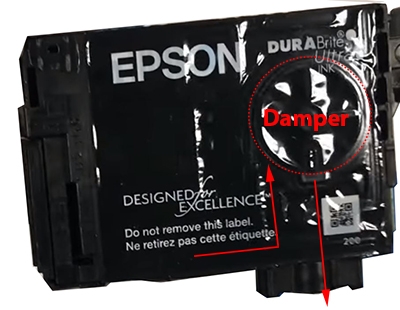
Another place that air bubbles can form is inside the printhead. We will take a closer look at where the cartridge feeds ink. There are small cone-shaped ink tubes (ink intake) on top of the printhead. When we change the cartridge, we may push some air into these intakes and create bubbles. This is why printers tend to clog right after a cartridge change.
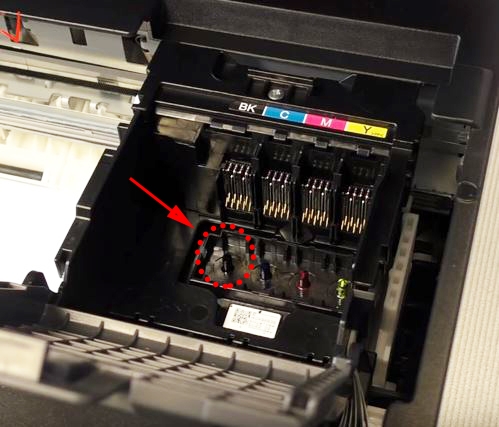
|
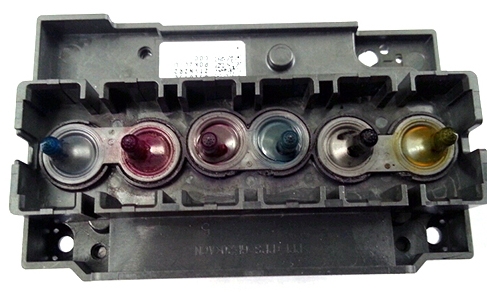
|
|
| Picture. The red circle indicates ink intake. | Picture. A close-up of the ink intake. |
To deal with the air bubbles, many HP and Canon printers have built-in pumps. For example, an HP printer pumps air into an internal bladder, which squeezes ink out of the cartridge, and therefore flushes the air bubbles (or dirt) out of the printhead. On the contrary, Epson relies on two things: 1) an internal one-way damper that makes ink flow one-way only. 2) a built-in cleaning function which uses an external waste pad to suck and wipe the printhead. Each built-in cleaning cycle will remove some ink out of the cartridge and then dump the ink on a waste pad. However, the waste pad is poorly designed and often experiences overflowing. Once the inkpad overflows, ink will remain on the printhead and dry. The dried ink will create more clogging and make things worse. Thus, we do not recommend doing more than three head cleanings in a row.
We can illustrate the above scenario with an example. Our printer is missing a color (clogged by air bubbles). We did 7-8 built-in cleanings continuously and got it to work correctly. The bubbles were sucked out with ink, and we got back to regular printing. A day later, we found the printer was clogged again. Although the cartridge didn’t have any air bubbles, the printhead was clogged by dried ink.
If you search the word "Epson unclog" on YouTube, you can see most people simulating HP's method. They inject fluid from the ink intake and collect waste ink with a paper towel underneath. However, this is a little bit of overkill for most clogs. Here at BCH, we perform this sequence, gradually increasing the effort and intensity of unclogging until a satisfactory result is reached.
Prevention
The best unclogging techniques are to start with prevention
Do not let the ink become depleted. If we allow the ink to become exhausted, then both the cartridge and the printhead will be full of air. When we refill a cartridge, we will use a syringe to suck the air from a cartridge’s outlet until we see ink coming out. Also, we may add a drop (1 ml) of Wetter Solution to each 100 ml ink to prevent it from drying
Built-In Cleaning Function
Epson's self-cleaning is the most under-estimated and misunderstood method. Actually, Epson built a very powerful cleaning routine in the printer, just people don't know how to utilize it. Most people only run one or two cleanings and give up. People worries that the cleaning will damage the printhead. Epson has a counter, that if we run more than 5 cleanings in a row, the printer will display "the printhead is damaged" and prevents from further cleaning. Therefore, we will never run more than three cleanings consecutively. We will run three cleanings, go to home screen (don't need to wait), and then go to maintenance tab and do the next batch of cleanings.
The following video shows how it is done, properly.
We will run the built-in "clean printhead" three times, then go to printer's home screen, then back to the maintenance screen and run three more times. Afterward, we wait 12 hours, and then run 6 more times (3+3). We usually repeat the procedure three times before giving up on this method. If the technique works, we will clean the ink pad to prevent ink from drying on the printhead.
How to clean waste ink pads?
We will turn on the printer. The printer will unlock the printhead and let it move freely. Before the printer locks the printhead again, we will unplug the power cord. Thus, we can move the printhead away from its resting position. Then we will be able to see the exposed waste ink pad. We will use a paper towel to suck up the excessive waste ink and then power on the printer.
Positive Pressure - Cartridge
Slight positive pressure will wash out the air bubbles too. If we have a refillable cartridge, we will unplug the refill hole. Once the top of a cartridge is open to the air, there will be slight pressure to push the ink down and move air bubbles up. For refilled OEM cartridges, we will peel off the sealing tape and expose the drill hole. These methods create a little downward pressure on the cartridge. We will leave the cartridge in the printer overnight. We will check the result a day later and see if we need to move on to the next step. Furthermore, we will clean the waste ink pad afterward.
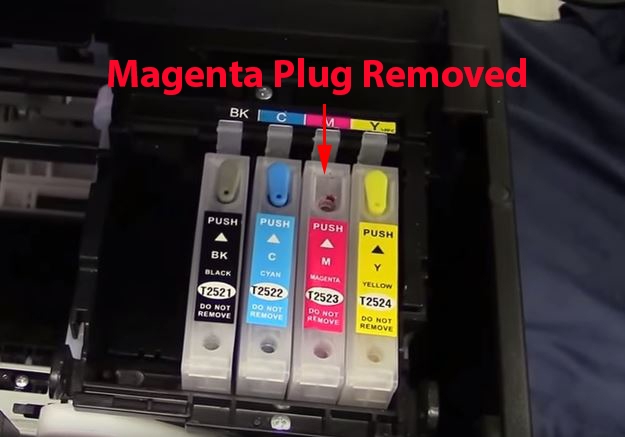
Positive Pressure - Titration or Waterfall Method
We can also use ink tubes to generate positive pressure. This kit (click here) consists of two tubes. These two different diameter tubes (1 ft each) can be cut and attached to each other. If we have 4 colors, we will cut each into 4 pieces, then connect to each other. The smaller tube will be attached to the ink intake and we can add cleaning solution to the larger tube. We then let the earth gravity to do the cleaning. The cleaning solution will gradually dissolve the clog and push open the nozzles. Once we see the cleaning solution is gone, we know the cleaning is completed. This video shows the process in action.
A less aggressive way of flushing the printhead
Wet Towel Method
If we decide the clog is due to dried ink, we can use a wet towel to soften the dried ink. We will unplug the printer while the printhead is unlocked, similar to the procedure in (2). We will put a wet paper towel, soaked with hot water or cleaning solutions (LINK), in the middle of the printer. Then we will slide the printhead over the towel and let the printhead sit on top of the sheet for a few hours.
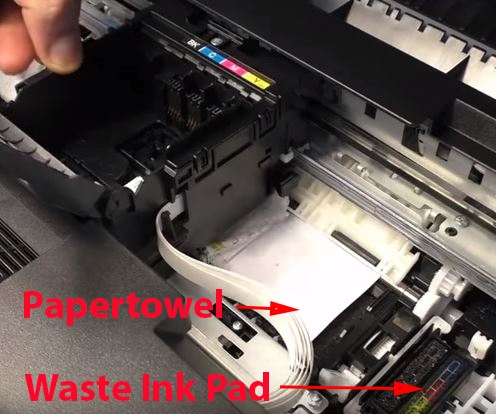
Printhead Flushing - Syringe
If we make a more rigorous attempt, we can remove the air bubbles and debris in the printhead by flushing it with liquid. We will take a syringe, fill it with liquid, and push the fluid through the cone-shaped ink intake. Some ink intakes fit a syringe, so we may not need special tools. A larger intake may need a tube to connect with the syringe.
If your printer's ink intake are "nipples", you can use this syringe: Size-S Syringe.

This method will flood the waste ink pad. Consequently, we will put a dry paper towel in the printer and slide the printhead on top of it, as in 4).
If your printer is equipped with a mesh intake, such as the models ET-8550 and XP-15000, instead of standard nipples, you will need to obtain a specialized adapter to facilitate flushing the system. Here's an example of what a mesh intake looks like:

- Unclogging Adapter for Epson Printhead Cleaning: ET-8550 ET-8500
- Unclogging Adapter for Epson Printhead Cleaning: XP-15000 XP-6000
What liquid should we use?
Ink. The original ink is the most non-intrusive way. A "golden rule" in the ink industry says the dried ink must be able to be dissolved by the same ink. So the best solution is to use the same kind of ink in the cartridge.
Ink Base. The ink base is the liquid for making the ink before adding colorant. The ink base is a kind of ink without color. The ink base is less messy and non-intrusive to the printhead. BCH produces two kinds of ink base: dye base and pigment base.
Warm water. Water is the cheapest solution. However, the printer cannot print on water, and we should flush it with a little ink afterward.
Cleaning Solutions. Cleaning Solution is used for stubborn clogs. The cleaning solution can add extra push if other liquids have failed.the appropriate cleaning solution depends on the type of ink your printer uses. At BCH Technologies, we provide three distinct cleaning solutions – clear, green, and red – each formulated for specific ink types to not only clear clogs but also to preserve the integrity of your printer's printhead. It’s essential to follow the instructions provided with each cleaning solution to achieve optimal results. The strength of cleaning solution increases from clear to green and the red is the max.
- Clear Cleaning Solution - Suitable for both dye and pigment inks. This is the mildest option, effective in dissolving stubborn clogs and restoring dried print nozzles. It’s eco-friendly and safe for all printer brands. Learn more and purchase this solution here.
- Green Cleaning Solution - Designed for dye, pigment, and now sublimation inks. This solution is a step up in strength, capable of tackling more resilient clogs. Its formulation is environmentally friendly and non-corrosive. For more details, visit here.
- Red Cleaning Solution - Our most potent cleaning agent, recommended for severe clogs and professional users. Effective on dye, pigment, and sublimation inks. However, it should be used cautiously and not be left in the printer for more than 24 hours at full strength. Further information can be found here.
For specialized needs like DTF or DTG inks, our Premium Cleaning Solutions for DTF Inks - MaxStrength™ Against White Ink Clog targets white ink clogs specifically and is also effective for DTF/DTG color inks. However, it is not suitable for dye ink and is intended for professional use due to its strength. More information and purchase options are available here. For the power of cleaning out pigment inks, this ink is stronger than the red solution.
Printhead Flushing - Cartridge
We can also take a set of refillable cartridges and fill them with cleaning solutions. Some people sell these as "cleaning cartridges".

Professional Cleaning
If the printhead flushing is not working, we may take the printhead out and clean it. We start by searching “remove xxx printhead” on YouTube. After we find a way to remove the printhead, we will take the printhead out.
First, we soak the printhead in cleaning solutions for a few hours. Then, we will use a high-pressure steamer to open up the nozzles and blow away debris. Finally, we will use an ultrasonic cleaner to remove clogging particles and dried ink.
This procedure should be done by professionals. We may lose a printhead this way. As a reference, we have a link here:
Videos:
Unclog Epson Artisan 1430
WF-3620 Won't Recognize Cartridge & Clogged
Unclog WF-3640
